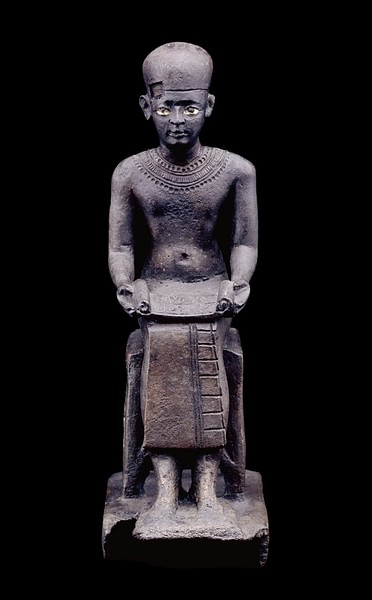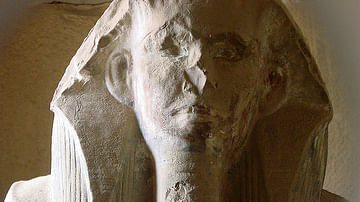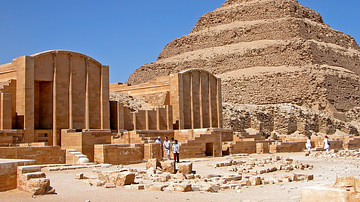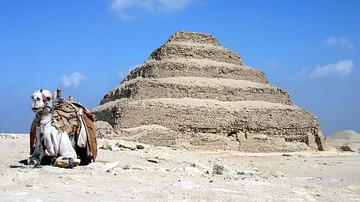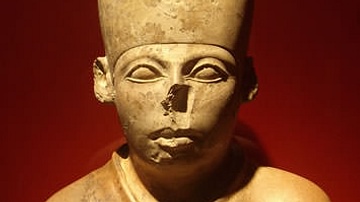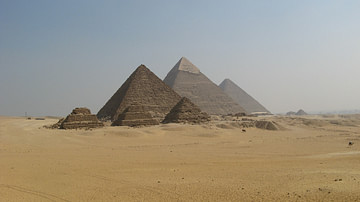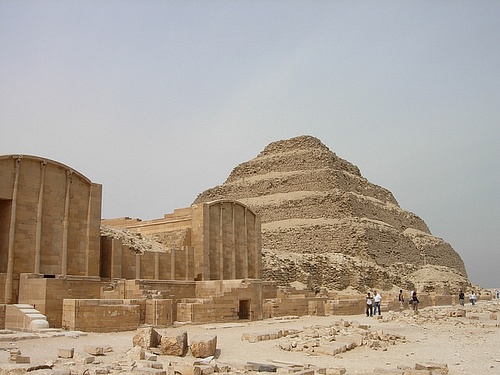
The Third Dynasty of Egypt (c. 2670-2613 BCE) begins with king Djoser, famous for his Step Pyramid at Saqqara. Although there are some sources which claim a king named Sanakht (also known as Nebra) founded the Third Dynasty, these claims are routinely challenged for lack of evidence. The chronology of Manetho is vague on who Sanakht was, when he ruled in the Third Dynasty, and even his name. Sanakht's name is only known through the Abydos king list, the Turin papyrus, and two reliefs found in the tomb known as Mastaba K2 at Beit Khallaf. This was once thought to be Sanakht's tomb but this identification has been challenged and refuted. Nothing is known of Sanakht's reign and his name may be a reference to some other king. Although few details are available on Djoser's reign, it is certain he was king at the beginning of the Third Dynasty and equally clear he followed the last king of the Second Dynasty, Khasekhemwy.
Scholars have routinely included the Third Dynasty in the period of the Old Kingdom (c. 2613-2181 BCE) rather than the Early Dynastic Period (c. 3150-2613 BCE) because of the grand building projects which characterize it. The construction of the first pyramid in the Third Dynasty, under Djoser, suggested to early archaeologists a clear link with the rise of the greatest pyramids in the Old Kingdom. Modern scholarship, however, tends to regard the Third Dynasty as belonging to the Early Dynastic Period owing to a continuation of cultural and architectural practices (religious observances and methods of building) which are more closely aligned with the past of Egypt than the future.
The first pyramid
Although Djoser's pyramid, designed by the architect and vizier Imhotep, is Egypt's first pyramid, it is closer in construction to the mastaba tombs of the Early Dynastic Period than the so-called 'true pyramids' of the Fourth Dynasty of the Old Kingdom. The development of pyramid building in the Third Dynasty moved from mastabas to the stacked mastabas of the step pyramids of Djoser, Sekhemkhet, and Khaba. These pyramids would later give rise to the monumental pyramids of Giza but, as noted, have more in common with the earlier mastaba than the later structures.
The Step Pyramid began as a simple mastaba tomb with a flat roof and sloping sides, along the lines of many such tombs from earlier dynasties. The architect Imhotep, however, had a grander scheme in mind for the eternal home of his king. The Step Pyramid is a series of mastabas stacked on top of each other, each level a little smaller than the one beneath, to form the shape of a pyramid. Earlier mastabas were constructed of clay brick but the Step Pyramid was made of stone blocks on which were carved images of trees (sacred to the gods of Egypt) and reeds (possibly symbolizing The Field of Reeds, the Egyptian afterlife). When completed, the Step Pyramid rose 204 feet (62 meters) high and was the tallest structure of its time. The pyramid complex included a temple, courtyards, shrines, and living quarters for the priests covering an area of 40 acres (16 hectares) and surrounded by a wall 30 feet (10.5 meters) high. The actual chambers of the tomb were dug beneath the base as a maze of tunnels with rooms off the corridors to discourage robbers and protect the body and grave goods of the king. This plan did not work, however, as the tomb was robbed in antiquity of all valuables including the king's body; only his foot was found in the tomb.
Still, the design and construction of the Step Pyramid epitomize the ingenuity and vision of the Third Dynasty builders who would later raise the Buried Pyramid and the Layer Pyramid among many other monuments and temples. These early visionaries lay the foundations for the later 'true pyramids' of the Fourth Dynasty which have intrigued and fascinated people throughout the centuries since their creation. During the Third Dynasty, architecture, technology, religion, and the arts took a huge step forward as the people planned and built these great tombs and monuments to their rulers. The pyramid was designed to house the mortal remains of a king and provide a home for his spirit to recognize and be able to travel to for visits to the earthly plane; whatever other designations or uses people have attributed to the pyramids in the centuries since they were built, this was their original purpose. Further, in spite of repeated claims to the contrary, neither these great works nor the later pyramids were built by slaves but by skilled Egyptian craftsmen and hired labor. Archaeological evidence makes clear that those who worked on the pyramids and other monuments throughout Egypt were paid or performed their duties as a service to the gods and to their king.
The design and construction of Djoser's step pyramid required the builders to think in larger terms than their predecessors. Formerly, a simple mastaba served well as a tomb but now the plan was to create a series of mastabas stacked on top of each other to reach toward the heavens, surrounded by a necropolis which would honor the dead and astound the living. In order to achieve this vision, old ways of building using mud-baked brick and wood were discarded in favor of stone and this single decision would influence Egyptian art and architecture for the next 2,000 years. Further, the technology required to move, shape and position the stone required innovative thinking and skill in stonework which was not necessary in earlier times.
These changes seem to have been brought about by the stability of Djoser's reign and the developments in religious concepts regarding the soul which this stability encouraged. The soul of the deceased was thought to have nine parts and one of them, the Ba, was bird-shaped and could descend again to earth or fly to the heavens. This concept, along with the long-established belief in a life after death, inspired the Egyptians to build grand houses for their pharaohs to house the physical body (the Khat) and enable the Ba to descend to visit it if it so chose. Djoser's pyramid, the first of its kind, epitomizes this belief and stands as a symbol of the inspiration and innovation of Imhotep and the builders of the Third Dynasty of Egypt.
Kings of the Third Dynasty
The following list of pharaohs of the Third Dynasty is based on Manetho's chronology, the Turin King List, and archaeological evidence as presented in Douglas J. Brewer's work, Ancient Egypt: Foundations of a Civilization.
Djoser (c. 2670 BCE; Greek Name: Tosorthros) reigned for over twenty years. He ruled over a stable country as evidenced by the luxury of being able to engage in a number of building projects. Djoser built so many monuments, tombs, and temples, in fact, that scholars have claimed he must have reigned for closer to thirty years. Military expansion into the Sinai region took place under his reign and industry and technology flourished as did the arts. His vizier, Imhotep, designed his burial place at Saqqara; the great Step Pyramid he is most famous for in the present day.
Sekhemkhet (c. 2650 BCE; Greek Name: Tyreis) was Djoser's eldest son (though possibly his brother) who ruled for less than ten years. He is best known for the so-called 'buried pyramid' (because it was discovered beneath the sand) at Saqqara. Some scholars now challenge the claim that the buried pyramid is Sekhemkhet's and believe it was built for his wife Djeseretnebi. He seems to have continued the policies of Djoser, including military campaigns in the Sinai region, as inscriptions from his reign have been found there.
Khaba (c. 2640 BCE) was the third king of the Third Dynasty although some scholars insist he was preceded by a man named Sanakht. Little is known of his reign other than through his building projects, including the Layer Pyramid at Zawyet el-Aryan near Giza and the complex which once surrounded it.
Huni (c. 2630-2613 BCE; Greek Name: Aches) was the last ruler of the Third Dynasty. Although he is referenced in later inscriptions, almost nothing is known of his reign. As there is no evidence of a disruption in the development of the culture, it could be assumed he continued the policies of his predecessors with success but there is no actual evidence for him doing so. He was originally thought to have built the Meidum Pyramid but that has now been positively identified with the Fourth Dynasty pharaoh Snefru. He has also been associated with Layer Pyramid by some scholars who equate Huni with Khaba, but this is contested. With Huni, the Third Dynasty ended and the Fourth began which initiated the period known in Egyptian history as the Old Kingdom.
